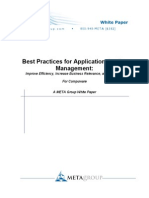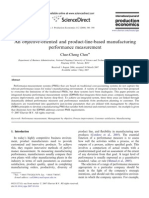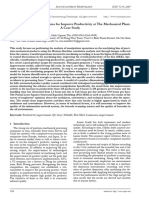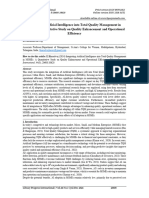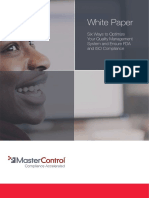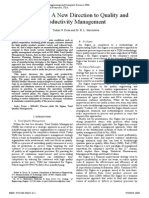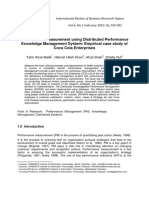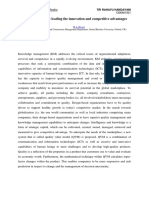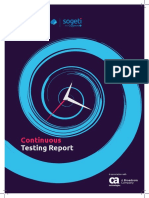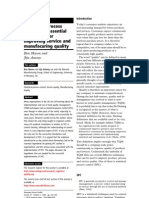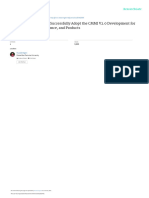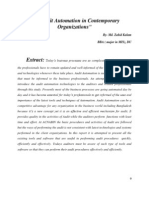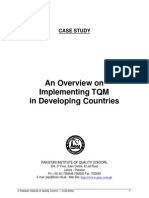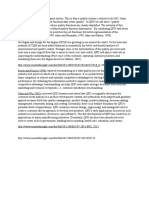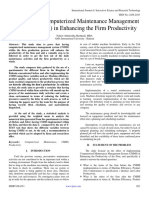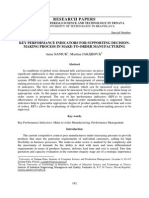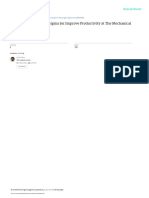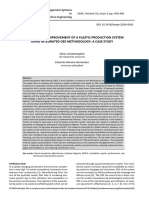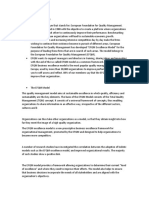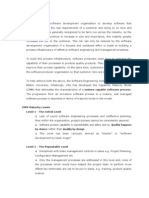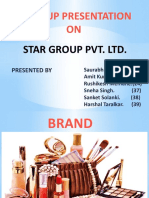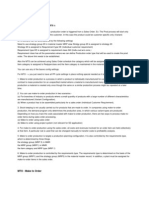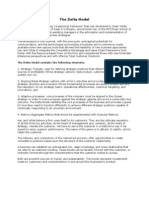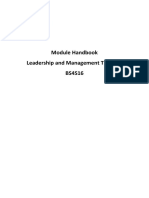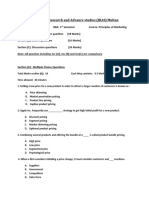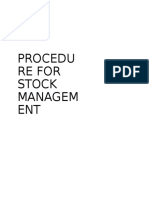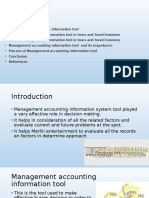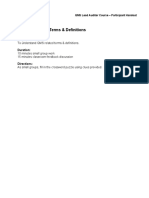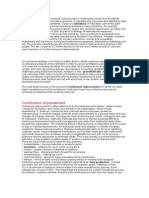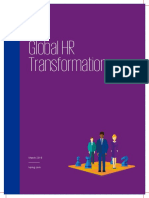HMIS Project Proposal
HMIS Project Proposal
Uploaded by
Manal KhanCopyright:
Available Formats
HMIS Project Proposal
HMIS Project Proposal
Uploaded by
Manal KhanCopyright
Available Formats
Share this document
Did you find this document useful?
Is this content inappropriate?
Copyright:
Available Formats
HMIS Project Proposal
HMIS Project Proposal
Uploaded by
Manal KhanCopyright:
Available Formats
AUTOMATION OF WORKING PROCEDURES IN QUALITY
AND PRODUCTION DEPARTMENT OF PHARMACEUTICAL
INDUSTRY
Manal Khan Niazi and Ajay Kumar
Prof. Dr. Ather Akhlaq
Supervisor
A THESIS SUBMITTED IN PARTIAL FULFILLMENT OF THE
REQUIREMENTS FOR THE DEGREE OF MASTER IN BUSINESS
ADMINISTRATION IN HEALTH MANAGEMENT
DEPARTMENT OF HEALTH & H
OSPITAL MANAGEMENT
INSTITIUTE OF BUSINESS MANAGEMENT
KARACHI-PAKISTAN
07, 2020
Chapter 1
INTRODUCTION
1.1 Background
Pharmaceutical makers are accomplishing huge advantages utilizing computerized
frameworks. Some have communicated plans to actualize a 'paperless domain' to make an
upper hand. Present FDA exercises have all the earmarks of being moving towards
electronic recognizable proof as equal substitutes to manual ID making mechanization a
feasible administrative reality. Producers are utilizing process mechanization, computer
integrated management system, e-work commands and hierarchical change the board as
components of operational procedures to help these new corporate objectives and targets.
Business re-designing, authoritative arrangements and business process investigation
are being utilized to make the data stream characterizing the smoothed out worth
included errands. Applications like procedure automation, information assortment
frameworks, programming items like QMS, SAP MRP run, product MRP and electronic
recognizable proof will give the information what's more, exchanges for this data stream.
Every application gives benefits inside its own practical condition. Nonetheless, these
advantages are amplified through the data coordination of the individual applications.
[ CITATION MAH \l 1033 ]
1.2 Research Objectives
To find out effects of automation in a pharmaceutical industry
To find out whether employees of the industry will easily adopt the automation of
Manal Khan Niazi (20202 – 26812)
Ajay Kumar (20161 – 26812)
the work or will face difficulty to move from manual work
To find out whether the quality will be affected after implementation of robotics
1.3 Problem Statement:
To study the effect of automation in pharmaceutical industry
1.4 Purpose of the study
The purpose of the study is to find out about awareness of robotics in pharmaceutical
industry and to implement robotic inspections especially in local industries so that people
could sort out their rejections 100%.
LITERATURE REVIEW
In a situation where financials, practicality, and quality run the organization, this is
fundamental to search for responses in innovation where these difficulties must be seen.
In a well-known pharmaceutical Quality affirmation site, automation and mechanical
autonomy have Become only the apparatuses to address these difficulties. In spite of the
fact that automation is a generally new idea in our specialization, we have completely
grasped it inside only a couple of years. As our organization experienced a mix, there was
a significant decrease staff in site where the quality confirmation division through
intentional and automatic partitions. Anyway the outstanding task at hand stayed steady
or in A few cases really expanded. So even with decrease in research center Work force,
they improve profitability while keeping up trustworthiness in Quality testing.
Benchmark examines showed the site to be the decision fabricating site above different
offices. This is credited to the site office workers' promise to decrease process duration,
improve efficiency, and keep up significant level of administrative consistence. One of
Manal Khan Niazi (20202 – 26812)
Ajay Kumar (20161 – 26812)
the more grounded contributing components was computerization Innovation in the
laboratories, and this innovation will Keep on helping the site's status later on. The
automation gathering was initially shaped around two years prior to meet the requests of
excellent confirmation testing throughput needs and to bring our testing bunch up to
norm with the business. Computerization started with just two individuals in the
gathering and now We have three individuals who are the cutting edge mechanization
researchers. Indeed, even with such a little stage, we have made incredible steps in
research center mechanization as we have worked broadly with each bit of gear acquired.
Nonetheless, with the association from the clients at 'get– Go', we had the option to
effectively get numerous computerization advancements. The fate of item testing lies in
computerization, and we will keep on investigating the conceivable outcomes of
improving the testing Strategies so the scientific experts will be less troubled with routine
and unremarkable day by day assignments and be more centered around bringing Quality
into our items.
The merger and in this manner the formation of company brought about difficulties that
must be tended to very quickly. These difficulties included lessening the Workforce,
reducing expenses, expanding efficiency, moving items from different locales, and
benchmarking the site as the head producing site. As these difficulties surfaced, the
quality affirmation division (working under specialized activities) reacted rapidly. One of
the reactions was the development of a computerization care group to acquire
frameworks that would build proficiency and efficiency and hence definitely cut
expenses for the research center tasks.
Manal Khan Niazi (20202 – 26812)
Ajay Kumar (20161 – 26812)
Taking a gander at the benefits of the multiple dose computerized disintegration
framework, one can without much of a stretch perceive how the flexibility in addition the
efficiency of the framework gives significant additions in testing items. A portion of the
detectable favorable circumstances of the framework include: fast and precise vessel
filling with chose media, exact environmental temperature examination, unit and
multipoint disintegration, efficient and fast container washing, up to eight groups for each
arrangement, and Interfacing ability to chemical testing methods or a division Gatherer.
Likewise, the robotized frameworks bring cost reserve funds that can be quantitatively
estimated.
As recently investigation of data frameworks chiefs demonstrated that various past usage
in computer integrated management system (CIM) had not accomplished their proposed
business objectives. Absence of financing what's more, the executives support seems, by
all accounts, to be the utmost exciting restrictions to executing cim. Per the study, better
mix of assembling data was a significant improvement region [ CITATION Spa94 \l 1033 ]
An overview on commercial hindrances to cim reasoned that framework arrangements
must address more than data innovation. A staggering 70% expressed that individuals,
just as preparing, associations, and changes in culture should be remembered for any
fundamental arrangement. All organizations are diverse in business headings, producing
styles and social points of view. So as to attempt cim programs, the executives will keep
on settling on choices based upon the investigation of a program's return for money
invested or budgetary commitment to the main concern [ CITATION MPo15 \l 1033 ]
Manal Khan Niazi (20202 – 26812)
Ajay Kumar (20161 – 26812)
Examinations like net present worth utilize present day suppositions. Different strategies
are more creative by not accepting that current industry what's more, organization
conditions will stay steady during the existence pattern of the program or by
characterizing key non-quantitative advantages just as customary monetary measures.
These strategies endeavor to invalidate the moderate bookkeeping maxim that appoints
zero an incentive to vital advantages of cim in order to be completely off-base to being
mysteriously right [ CITATION DHS91 \l 1033 ]
Potential advantages can be found in data sharing through utilitarian mix by methodical
methods and enabled laborers in every aspect of manufacturing which includes many
systems i.e., planning and execution of manufacturing resources, quality management
processes, quality control, CAPA and change control management, calibration and
maintenance of equipment in manufacturing facility, in process checks and process
controls etc [ CITATION JWi91 \l 1033 ], [ CITATION JWi94 \l 1033 ]
All regions where the future state is not the same as the current condition speak to
possible wellsprings of advantages as expanded profitability, more noteworthy
efficiencies, justification of roundabout errands, better usage of heritage process control
frameworks and cost shirking. These advantages should be evaluated without trading off
administrative consistence and assembling control to be valuable [ CITATION Mes93 \l 1033
Total quality management (TQM) way toward improving the board of a whole
association with the goal that it exceeds expectations in all perspectives of items and
administrations; it has accomplished more consideration in latera long time in the human
Manal Khan Niazi (20202 – 26812)
Ajay Kumar (20161 – 26812)
services industry. It is fundamentally a dedication to consistent, enhancement in
qualification from all aspects, to the most significant level administration to the lowest
employee level, from the crude materials provider through the gracefully chain to the end
shopper. In a profoundly computerized information catch condition, such thoughtfulness
regarding quality has become a precondition for greatness; these realities will be shown
in the two contextual investigations of cardiovascular checking frameworks. Quality
affirmation in the social insurance field and the responsibility required are essential all
together effectively contend in the worldwide commercial center as a world-class
association. As indicated by 02 members in (2006), the seven segments of TQM
incorporate nonstop improvement, six-sigma, worker strengthening, benchmarking,
without a moment to spare (JIT) stock, taguchi ideas, what's more, TQM apparatuses.
Ceaseless development and six-sigma are utilized to improve existing items and lessen
surrenders throughout creation, to bring down expenses and spare time. Worker
strengthening joins the workers in ordinary administration and dynamic, improving
response time and execution, and bringing about more joyful workers. JIT stock
administration is another case of nonstop improvement, for example, decreased physical
stock in a distribution center methods spared costs in diminished overhead, mistakes and
imperfections can be immediately recognized and fixed. Taguchi ideas bring about hearty
items and target-arranged quality [ CITATION DSm08 \l 1033 ]
While TQM and automatic identification and data capture (AIDC) accomplishments
increase company and service of product, application of TQM is not easy, since it usually
involves changes in culture of organization. The situation is not essentially factual for
AIDC-related techniques since the variations operational and management can see cost
Manal Khan Niazi (20202 – 26812)
Ajay Kumar (20161 – 26812)
reduction in a short span. However, TQM application needs changes in entire system to
gain enhance business performance and employee behavior could be change [ CITATION
Ehi06 \l 1033 ]
TQM needs a solid assurance from top Management, who should monitor the entire
system in every aspect, which need to be change with a new organizational demands
[ CITATION Str07 \l 1033 ]
Numerous TQM components are individuals situated and incorporate practices Such as
collaboration and worker strengthening. A few Researchers have demonstrated that
specific character traits from Management and workers are basic for TQM consistence.
TQM needs Individuals who are exceptionally friendly, to exhibit worry for customers
and constantly improve consumer loyalty; components That are basic in advertising
wellbeing administrations. Since numerous administrators May experience issues
surrendering their places of power, to permit Employees more noteworthy cooperation in
the dynamic procedures; TQM usage in these cases work may flop because of absence of
Management support. A responsibility must be additionally made to The consistent
improvement of the item. Careful testing and examination must be made to diminish
deformities to the point of Zero imperfections through the procedure of constant
improvement. Complete and exhaustive records must be kept and workers or
Management the same that don't have the assurance may cause a Failure of TQM usage
[ CITATION Sil07 \l 1033 ]
An expanding realization of the prerequisite to support Quality Management System
(QMS) activities to a great extent on account of expanding quality-based rivalry.
Manal Khan Niazi (20202 – 26812)
Ajay Kumar (20161 – 26812)
However, while QMS activities are today seen more comprehensively and genuinely than
they were already, there still is by all accounts a shortage of cognizant frameworks and
methods to help quality confirmation. There is no occurrence that nobody ever present,
pc based assembling control frameworks has a coordinated module committed to quality
affirmation.
Absence of sufficient data frameworks saw to be common inside and out the
organizations with quality issues, and the measure of declaring point of interest
corresponded intimately with contrasts in quality execution. The point of this paper is to
plan a fundamental system for remembering the quality measurement industrial facility
computerization data of a common discrete-parts maker. It's notable that a dominant part
of firms goes under the classification of cluster fabricate. While developing the
framework of QMS in organization system, we should consider the changing examples in
quality administration and furthermore the advancements in adaptable computerization
going down during this specific circumstance [ CITATION Alf13 \l 1033 ]
The effect of value due to computer system coordinated assembling is by all accounts
critical, both by method of requiring changes in interior control methodology and
furthermore through the consequence of higher and more reliable quality. What's more,
changes to existing interior control methodology in 72%. In a primer overview on
manufacturing plant automation in 67 US organizations, upgrades in quality happened in
65% of the organizations. However, upgraded item quality neglected to figure as a key
thought inside the presentation of manufacturing plant mechanization in any of those
organizations, in spite of the fact that it's broadly realized that predictable item quality is
one among the significant advantages of computerization [CITATION Eli07 \l 1033 ]
Manal Khan Niazi (20202 – 26812)
Ajay Kumar (20161 – 26812)
Chapter 3
RESEARCH DESIGN & METHODOLOGY
3.1 Design of the study
The design of the data is based on qualitative analysis, i.e. interview based
approach. It covers detailed explanation of investigation. The technique was selected so
that we can analyze the quality of work [ CITATION Onw12 \l 1033 ]. Qualitative data
provide strength to the research.
3.2 Study setting
The study was conducted in different pharmaceutical industry of Karachi, Pakistan.
Pharmaceutical industries have a big power in business world of Karachi, Pakistan.
[ CITATION Gha12 \l 1033 ]
3.3 Target population
People who are working in quality assurance and production department of
Pharmaceutical industries in Karachi, Pakistan. The population targeted from both
Manal Khan Niazi (20202 – 26812)
Ajay Kumar (20161 – 26812)
multinational and local pharmaceutical to eliminate the factor of biasness and to approach
our results from every setting.
3.4 Sample size
12 people and industries were selected for sample size but some of the respondents
had denied to share their views as it was against organization’s policies. The sample
contains both middle level management and higher level management.
3.5 Instrument / measure design
The instrument was designed in the format of interview based questionnaire.
Following questions were asked:
a) How your organization deals with the processes? Are they automated or
manual?
b) What do you think how will your employees will react towards the changes
implemented?
c) Do you think if automation will be implemented, what will be the risk – benefit
analysis?
d) In your opinion how can be the automation is better than manual work?
3.6 Duration of the study
The time period of the research was from June 2020 to august 2020
3.7 Method of data collection
The interview was taken by face to face conversation and also on phone calls. No
third person was included in taking interviews to maintain accuracy of results
Manal Khan Niazi (20202 – 26812)
Ajay Kumar (20161 – 26812)
Chapter 4
DATA ANALYSIS & RESULTS
The results are identified in this chapter along with its interpretations and findings
in relevance to the hypotheses tested.
4.1 Demographics Profile
There are 8 respondents who were willingly agreed for their interview out of 12
respondents we selected in which there are 5 females and 3 males candidate. We had
approached Quality Assurrance and Production Department of Pharmaceutical industries
to review how the deal with their processes. The individual;s who had willingly gave
their interviews are composed of Quality Assurrance Officer (n=2), Sr. Quality
Assurrance Officer (n=2) Quality Assurrance Manager (n=1), Production Officer (n=2)
and production Manager (1). Participants those had denied for giving interview are both
QA and Production Officer combinely (n=4)
Participant’s demographics are listed below:
Table 1: Demographics of participants
CHARCTERISTICS NUMBERS
GENDER
MALE 3
FEMALE 5
DESIGNATION
SR. QUALITY ASSURRANCE
2
OFFICER
QUALITY ASSURRANCE OFFICER 2
QUALITY MANAGER 1
PRODUCTION OFFICER 2
PRODUCTION MANAGER 1
Manal Khan Niazi (20202 – 26812)
Ajay Kumar (20161 – 26812)
4.2 Analytical Results
We had conducted total 4 questions as are selected participants do not responds much
questions for detailed answers. The statements are given below
i. Question no 1: How your organization deals with the processes? Are they
automated or manual?
a. we are dealing with the manual processes. For example we do our in
process by checking the volume of liquid of syrups, solutions and drops by
volumetric cylinder, for injection we check volume by syringe. For tablets
we check the following parameters: weigh tablets in weighing balance,
test of disintegration to check the disintegration time, we do friability test,
dissolution test, hardness test and we check the diameter and thickness by
vernier caliper
b. we deal with automatic and semi automatic machines. These both are very
efficient in their working
c. As our organization is newly developed company so initially we are dealing with
mostly manual processes. but further we are looking forward for automation
d. we deal with semi automated processes. Like manually we check weight of our
dispensed product. We do not have such machines that could be use for our
trial batches so we perform many processes manually like seiving and drying of
granules
e. we deal with automated processes. We have checkwares on each and every
point so that there wil be no chances of error at any stage.
ii. Question no 2: What do you think how will your employees will react towards
the changes implemented?
Manal Khan Niazi (20202 – 26812)
Ajay Kumar (20161 – 26812)
a. We would face very difficulty as our most of the employees are working here in
manual system. if we suddenly provide them with automatic machines their
reaction would not acceptable
b. Start with leadership, Everyone maksure that change is postive and benefit
them personally
c. They will not be happy since they can feel insecure towards the change
d. our employess will definitely get happy if we could made changes to ease their
work and probably they will work more hard
e. our employess would show positive attitude toward changes as we are
providing them trainings for the new changes, their knowledge will be increased
iii. Question no 3. Do you think if automation will be implemented, what will be
the risk - benefit analysis?
a. Whether it is automated or manual system there must be some pros and cons
of it. on one hand it can decrease human error, so on the other hand human
negligence can be occurred. on one hand labour work is reduced so on the other
hand your employees would have no work to do.
b. Better technology and IT facility with good back up required as well as
individuals needs to be trained properly and assessed
c. More efficent production, Higher labour productivity, Cheaper goods increases,
Can remove risk of human error, Consumer satisfaction
d. if we move to automation from semi automation the risks would be much lesser
than the benefits. Because we can give much more production which could
increase our demand in market
e. benefit is that we get more advance technology and trainings which can
increase our knowledge and risk is that the importance of original signed
Manal Khan Niazi (20202 – 26812)
Ajay Kumar (20161 – 26812)
document would not be considered and employees show carelessness towards
that original signed document
iv. Question no 4: In your opinion how can be the automation is better than manual
work?
a. automation is much better that manual work so there shall be less paper work.
every thing you want can be easily accessible in a minute. you would not have to
search thing which can be obviously very time consuming
b. It provides error free data. Maintains data integrity, Time saving
c. Automation can actually deliver better results because of its ability for increased
coverage.
d. automated work can decrease human error. It can ease your work. It is less time
consuming. Risks can be eliminated and also identified during production
e. as I told before that it will be less time consuming. Moreover we can give more
production so company will prosper. If in future we face any problem regarding
market complains, so we can easily access the stage through our automated
systems
Chapter 5
DISCUSSION AND CONCLUSION
Discussions based on your findings in context with the past research findings.
Some recommendations and implications are also mentioned with the future research
Possibilities to the research conducted. This chapter may include the following:
Manal Khan Niazi (20202 – 26812)
Ajay Kumar (20161 – 26812)
5.1 Discussions
The results of the study has shown that local pharmaceuticals are dealing with
manual processes mostly but as we move forward to the higher level of organization i.e.
from local to multinational the systems and processes also move towards manual to
semi-automatic or only automatic systems.
The study has revealed that if changes were implemented in multinational
pharmaceuticals their employees shows positive attitude towards the changes. They
would be happy to work on modern technology whereas, in local pharmaceuticals if
changes implemented then the behavior of the employees would not expected as positive,
their employees would feel insecure towards the changes as they are not well trained
Respondents from every pharmaceutical had told us that risks of automation could
be carelessness attitude, they would neglect importance of original signed documents as
they everything is secure in their systems. Whereas, benefits of automation could be less
time consuming, elimination of human error, backup can be easily accessible, time
management could be handled properly, market value and demand would increase,
coverage would increase, cost would decrease, market complaints and obligations could
be eliminated, risks could be managed or eliminated.
5.2 Conclusions
The study has concluded that for the dealing of procedures in quality and
production department, automation is much better than manual work. It has been proven
by interviewing our respondents who were consist of both middle level management and
higher level management of pharmaceutical industries of Karachi. But there are also
Manal Khan Niazi (20202 – 26812)
Ajay Kumar (20161 – 26812)
pharmaceuticals whose employees would not be happy if their procedures move towards
automation as they would feel insecure there. In that case its organization’s responsibility
to train their employees with the new technology before implementation so that the
environment would remain healthy with the changes.
References
Bhatnagar, N. (2019, March). Role of Robotic Process Automation in Pharmaceutical Industries.
The International Conference on Advanced Machine Learning Technologies and
Applications. doi:https://doi.org/10.1007/978-3-030-14118-9_50
Ghayas , M. M., & Siddiqui, S. J. (2012). Impact of Job Satisfaction on Turnover Intentions in the
Pharmaceutical Industry of Karachi. South Asian Journal of Management Sciences , 6(2),
42-49.
MAHMUD, I., & KIM , D. (n.d.). Implementation of and experiences with new automation.
Journal of Analytical Methods in Chemistry, 22. doi:10.1155/S1463924600000353
Mahmud, I., & Kim, D. (2000). Implementation of and experiences with new automation. Journal
of Automated Methods & Management in Chemistry, 22(6).
Onwuegbuzie, A., Leech, N., & Collins, K. (2012). Qualitative Analysis Techniques for the Review
of the Literature. The Qualitative Report, 17(56), 1-28.
S. Newman, T., & Anil K, J. (1995). A Survey of Automated Visual Inspection. Computer Vision
nad Image Understanding, 61(2), 231 - 262. doi:https://doi.org/10.1006/cviu.1995.1017
Sindh Bureau of Statistics. (2017). Sindh at a Glance. Retrieved from Sindh Bureau of Statistics:
http://sindhbos.gov.pk/
Singh, R. (2018). Automation of continuous pharmaceutical manufacturing process. Computer
aided Chemical Engineering, 41, 431-446. doi:https://doi.org/10.1016/B978-0-444-
63963-9.00017-8
Smith, F. (2002). Research Methods in Pharmacy Practice. Pharmaceutical Press.
Manal Khan Niazi (20202 – 26812)
Ajay Kumar (20161 – 26812)
You might also like
- Chapter 1 Small Business An OverviewDocument28 pagesChapter 1 Small Business An OverviewHASNA KHAMIRI100% (1)
- Service Internship ReportDocument46 pagesService Internship ReportNadeem80% (5)
- Best Practices For Application Quality ManagementDocument9 pagesBest Practices For Application Quality ManagementAnselmoNo ratings yet
- 10.1108@ijqrm 07 2020 0232Document33 pages10.1108@ijqrm 07 2020 0232Ricardo Piero Esteban NúñezNo ratings yet
- An Objective-Oriented and Product-Line-Based Manufacturing Performance MeasurementDocument11 pagesAn Objective-Oriented and Product-Line-Based Manufacturing Performance MeasurementGalih PermadiNo ratings yet
- Six SigmaDocument8 pagesSix SigmaRajat KhullarNo ratings yet
- 5 - Application of Lean Six Sigma For Improve Productivity at The Mechanical Plant A Case StudyDocument15 pages5 - Application of Lean Six Sigma For Improve Productivity at The Mechanical Plant A Case Studyleylagale27No ratings yet
- Incorporating Generative AI Into Quality Management Systems Enhancing Process Optimization and Product DevelopmentDocument8 pagesIncorporating Generative AI Into Quality Management Systems Enhancing Process Optimization and Product Developmentrobert23a1999No ratings yet
- Six Sigma in Telco's PDFDocument7 pagesSix Sigma in Telco's PDFsiebrand982100% (2)
- Impact of Information Systems Capabilities and Total Quality Management On The Cost of QualityDocument11 pagesImpact of Information Systems Capabilities and Total Quality Management On The Cost of QualityAleksandra RandjelovicNo ratings yet
- Dr.K.bharadwajDocument13 pagesDr.K.bharadwajaalvis2409No ratings yet
- Six Ways To Optimize Your Quality Management System and Ensure Fda and Iso ComplianceDocument6 pagesSix Ways To Optimize Your Quality Management System and Ensure Fda and Iso ComplianceDavid GeorgeNo ratings yet
- Six Sigma Case StudyDocument6 pagesSix Sigma Case StudyIslamSharaf100% (1)
- 14 Dimensions and Measures of Manufacturing PerformanceDocument6 pages14 Dimensions and Measures of Manufacturing PerformancekhmortezaNo ratings yet
- 1-VOL27 EditedDocument27 pages1-VOL27 EditedCarwell AbatayoNo ratings yet
- Harkan, 2007Document11 pagesHarkan, 2007Rashid JehangiriNo ratings yet
- Chapter 1 Tatenda ChirataDocument4 pagesChapter 1 Tatenda Chiratadorcasmandivenga2000No ratings yet
- A DEA Approach For Evaluating Quality Circles: Sathasivam Mathiyalakan and Chen ChungDocument12 pagesA DEA Approach For Evaluating Quality Circles: Sathasivam Mathiyalakan and Chen ChungmanipsgNo ratings yet
- 23 Tahir PDFDocument33 pages23 Tahir PDFAli Raza RahmaniNo ratings yet
- Total Quality Managment in Construction PDFDocument5 pagesTotal Quality Managment in Construction PDFNesagolubacNo ratings yet
- Can Benchmarking Through TQM Implementation Improve Performance?: Some Empirical EvidenceDocument20 pagesCan Benchmarking Through TQM Implementation Improve Performance?: Some Empirical Evidencemaniz10No ratings yet
- Quality Revolution: Leading The Innovation and Competitive AdvantagesDocument4 pagesQuality Revolution: Leading The Innovation and Competitive AdvantagesHwan Tae RiNo ratings yet
- ISO 9000 - Key Skills For Squeezing The Lemon: Case StudyDocument4 pagesISO 9000 - Key Skills For Squeezing The Lemon: Case Studykoib789No ratings yet
- Quality Management System (QMS) Implementation in Manufacturing IndustriesDocument27 pagesQuality Management System (QMS) Implementation in Manufacturing Industrieskiranjames7No ratings yet
- Implimantation of Statistical Process Control in Small Scale Industries-A ReviewDocument4 pagesImplimantation of Statistical Process Control in Small Scale Industries-A ReviewijeteeditorNo ratings yet
- World Class ManufacturingDocument15 pagesWorld Class ManufacturingOmprakashNo ratings yet
- Capgemini Continuous Testing Report 2019 1564884718Document36 pagesCapgemini Continuous Testing Report 2019 1564884718Mudit KumarNo ratings yet
- Statistical Process Control: An Essential Ingredient For Improving Service and Manufacuring QualityDocument6 pagesStatistical Process Control: An Essential Ingredient For Improving Service and Manufacuring QualityNilakshi RathnayakeNo ratings yet
- Impact of TQM Implementation On Productivity and Quality - A Study at Genaral MotorsDocument12 pagesImpact of TQM Implementation On Productivity and Quality - A Study at Genaral Motorsmochammad fadliNo ratings yet
- Benefits of Six Sigma in Supply Chain MaDocument8 pagesBenefits of Six Sigma in Supply Chain MaAjayi AugustineNo ratings yet
- Fall 2022 - MGT619 - 8 - MC200401935Document24 pagesFall 2022 - MGT619 - 8 - MC200401935Afzal MuhammadNo ratings yet
- Quality Management Practices by TVS Group IndiaDocument19 pagesQuality Management Practices by TVS Group Indiasnata92No ratings yet
- Dokumen 4Document31 pagesDokumen 4yuyanNo ratings yet
- Six Sigma MethodologyDocument10 pagesSix Sigma MethodologyOmprakashNo ratings yet
- Practical Suggestions To Successfully Adopt CMMIv2.0Document5 pagesPractical Suggestions To Successfully Adopt CMMIv2.0AnoniemNo ratings yet
- Emma WorkDocument7 pagesEmma Workoluwasegunnathaniel0No ratings yet
- Shaping A New Era in Energy PDFDocument4 pagesShaping A New Era in Energy PDFRafael FernandezNo ratings yet
- #04 Intra Inter Process Continuous Auditing (IIPCA), Integrating CA Within An Enterprise System EnvironmentDocument24 pages#04 Intra Inter Process Continuous Auditing (IIPCA), Integrating CA Within An Enterprise System EnvironmentorchittaNo ratings yet
- Operation Management Navnit PGFA2062Document2 pagesOperation Management Navnit PGFA2062NAVNIT CHOUDHARYNo ratings yet
- Process Flow and Operations Management Within Food-Processing Factories (E-Track)Document6 pagesProcess Flow and Operations Management Within Food-Processing Factories (E-Track)LoganGunasekaranNo ratings yet
- Audit AutomationDocument49 pagesAudit AutomationZahid KalamNo ratings yet
- Kamran Moosa - An Overview of Implementing TQM in Developing CountriesDocument20 pagesKamran Moosa - An Overview of Implementing TQM in Developing CountriesImran RjnNo ratings yet
- 10.47750 pnr.2022.13.s10.129Document9 pages10.47750 pnr.2022.13.s10.129Enmanuel Alexander Condori GarayNo ratings yet
- Tesis Eñlementos FinitosDocument13 pagesTesis Eñlementos FinitosIvan VillamizarNo ratings yet
- Ermer and Kniper (1998)Document1 pageErmer and Kniper (1998)mahesa parameswaraNo ratings yet
- The Effect of Computerized Maintenance Management System (CMMS) in Enhancing The Firm ProductivityDocument5 pagesThe Effect of Computerized Maintenance Management System (CMMS) in Enhancing The Firm ProductivityInternational Journal of Innovative Science and Research TechnologyNo ratings yet
- Performance Measurement and Evaluation in An Innovative Modern Manufacturing SystemDocument18 pagesPerformance Measurement and Evaluation in An Innovative Modern Manufacturing Systemsitotaw0946No ratings yet
- Quality Management Systems and Service Delivery in Parastatals in Kenya: A Case Study of Kenya Plant Health Inspectorate Service (Kephis)Document11 pagesQuality Management Systems and Service Delivery in Parastatals in Kenya: A Case Study of Kenya Plant Health Inspectorate Service (Kephis)International Journal of Innovative Science and Research TechnologyNo ratings yet
- Module 3Document47 pagesModule 3ashir807No ratings yet
- Ijaiem 2013 06 14 043Document7 pagesIjaiem 2013 06 14 043editorijaiemNo ratings yet
- Driving Continuous Improvement by Developing and Leveraging Lean Key Performance IndicatorsDocument10 pagesDriving Continuous Improvement by Developing and Leveraging Lean Key Performance IndicatorskellendadNo ratings yet
- Research Papers: Key Performance Indicators For Supporting Decision-Making Process in Make-To-Order ManufacturingDocument9 pagesResearch Papers: Key Performance Indicators For Supporting Decision-Making Process in Make-To-Order Manufacturings3254No ratings yet
- Cost of Poor Quality 1Document7 pagesCost of Poor Quality 1Shavin AvinNo ratings yet
- Effects of Total Quality Management On Performance of Construction Industry in Tanzania: A Case of Construction Companies in MwanzaDocument8 pagesEffects of Total Quality Management On Performance of Construction Industry in Tanzania: A Case of Construction Companies in MwanzaInternational Journal of Innovative Science and Research TechnologyNo ratings yet
- Case Study 1Document4 pagesCase Study 1KokoriaNo ratings yet
- D Wave Hyperion Research Report 2024Document31 pagesD Wave Hyperion Research Report 2024Pranay PandeyNo ratings yet
- 02 02 1Document18 pages02 02 1ptdbsNo ratings yet
- MFT 001823 Fin-0003Document19 pagesMFT 001823 Fin-000321104071No ratings yet
- Evaluation_and_Improvement_of_a_Plastic_ProductionDocument14 pagesEvaluation_and_Improvement_of_a_Plastic_ProductionUtkarsh MalhotraNo ratings yet
- Empirical Investigation of Mediating Role of Six Sigma Approach in Rationalizing The COQ in Service OrganizationsDocument14 pagesEmpirical Investigation of Mediating Role of Six Sigma Approach in Rationalizing The COQ in Service OrganizationsAleksandra RandjelovicNo ratings yet
- Operations and Process Management: Methods and Techniques to Efficiently Manage Operations and Improve Productivity: Administration: The science of managing resourcesFrom EverandOperations and Process Management: Methods and Techniques to Efficiently Manage Operations and Improve Productivity: Administration: The science of managing resourcesNo ratings yet
- CRM Final AssessmentDocument3 pagesCRM Final AssessmentMinahil ShaheenNo ratings yet
- Material Requirement Planning (MRP)Document21 pagesMaterial Requirement Planning (MRP)naveenNo ratings yet
- What Is The EFQM ModelDocument5 pagesWhat Is The EFQM ModelHeba HemdanNo ratings yet
- CMM - GistDocument4 pagesCMM - Gistatmiya2010No ratings yet
- Albrechts Value-Process FrameworkDocument22 pagesAlbrechts Value-Process FrameworkMariver LlorenteNo ratings yet
- Removing Barriers in The Value Chain - Mashreq Construction Report 9 1Document28 pagesRemoving Barriers in The Value Chain - Mashreq Construction Report 9 1Ihab RamlawiNo ratings yet
- A Group Presentation ON: Star Group Pvt. LTDDocument13 pagesA Group Presentation ON: Star Group Pvt. LTDmonsterNo ratings yet
- Esg Batch IV 2024Document6 pagesEsg Batch IV 2024sundarsaranNo ratings yet
- 6 ISO 9000 ImplementationDocument30 pages6 ISO 9000 ImplementationIgnou DelhiNo ratings yet
- MTS VS MtoDocument39 pagesMTS VS MtoVenkat Palla100% (1)
- HR Min Call CentreDocument9 pagesHR Min Call CentreShaxil AliNo ratings yet
- The Delta ModelDocument3 pagesThe Delta Modelrravikumar4495No ratings yet
- Module Handbook Leadership and Managemen PDFDocument6 pagesModule Handbook Leadership and Managemen PDFperelapelNo ratings yet
- Marketing BBA 3rd (Mock) First Half Junaid AhmedDocument8 pagesMarketing BBA 3rd (Mock) First Half Junaid AhmedJunaid Ahmed100% (1)
- Marketing Mix Answer FullDocument8 pagesMarketing Mix Answer FullRituNo ratings yet
- Nov 2018 MTP IiDocument2 pagesNov 2018 MTP Iiforore8904No ratings yet
- Strategy 2 MarksDocument22 pagesStrategy 2 MarksUva RajeshNo ratings yet
- Stock Management PolicyDocument7 pagesStock Management PolicySatish Pareek100% (3)
- Notes For Supply Chain ManagementDocument18 pagesNotes For Supply Chain ManagementDanny GloverNo ratings yet
- Management Accounting Information As A Decision Making ToolDocument10 pagesManagement Accounting Information As A Decision Making ToolmaryathomesNo ratings yet
- 03 - Exercises - Participant HandoutDocument33 pages03 - Exercises - Participant Handoutnandhu sampath100% (1)
- Procurement Vol2 AppendixDocument124 pagesProcurement Vol2 AppendixModesty GumbieNo ratings yet
- Corus Case StudyDocument2 pagesCorus Case StudyGaurav GargNo ratings yet
- Review On Software TestingDocument20 pagesReview On Software Testingmarilou ranoyNo ratings yet
- HR TransformationDocument12 pagesHR TransformationBoonaa Sikkoo MandooNo ratings yet
- SAP CaseStudyDocument3 pagesSAP CaseStudydigitalbusiness1191No ratings yet
- Outline - An Analysis of Cyber Security Threats in Digital MarketingDocument2 pagesOutline - An Analysis of Cyber Security Threats in Digital MarketingFRISCA FITRIANo ratings yet
- The Paper On InnosonDocument3 pagesThe Paper On InnosonAhmed YusufNo ratings yet


